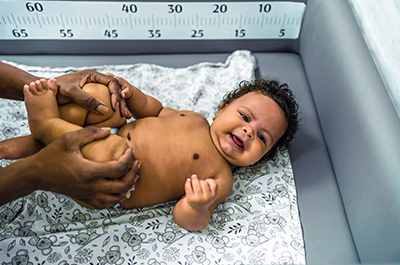You might know that those with celiac disease are sensitive to gluten, but celiac disease isn’t your classic food allergy. It’s actually an autoimmune condition that damages the small intestine and prevents the body from absorbing nutrients. When someone with celiac disease eats gluten, the immune system recognizes it as a foreign invader and tries to “attack” the small intestine.
“While some children outgrow food allergies, you can’t ‘outgrow’ celiac disease,” says Jordan Kridler, M.D., a pediatrician at Henry Ford Health. “The only way to heal the small intestine and prevent symptoms and complications of celiac disease is by adhering to a gluten-free diet.”

Pediatrics At Henry Ford
If celiac disease goes undiagnosed, children may develop significant nutrient deficiencies and growth delays. Here, Dr. Kridler shares risk factors and symptoms of celiac disease—plus, how to develop a nutritious gluten-free meal plan for your child.
Risk Factors For Celiac Disease In Kids
Celiac disease is a genetic condition, meaning you are predisposed to it from birth. But that doesn’t mean it will develop at birth. “Some studies suggest that those who are predisposed to celiac disease only develop it when there’s sufficient gluten in their diet for a long period of time,” says Dr. Kridler. Other studies show that undergoing a stressful or traumatic event, or contracting an infection—such as the flu—can cause celiac disease to develop in predisposed individuals.
Factors that may predispose children to developing celiac disease include:
- Having a first- or second-degree relative who has celiac disease. (A first-degree relative is an immediate family member; a second-degree relative is an aunt, uncle, grandparent, half sibling, etc.)
- Having certain genetic disorders such as Turner syndrome, Williams syndrome and Down syndrome.
- Having autoimmune conditions such as type 1 diabetes or juvenile arthritis. “If you have one autoimmune disease, you’re more likely to have other autoimmune diseases,” says Dr. Kridler. “That’s why children who have type 1 diabetes are also often tested for celiac disease.”
Symptoms Of Celiac Disease In Kids
Celiac disease usually doesn’t develop until after 6 to 9 months of age, when children are first exposed to gluten. Some children will develop it earlier in childhood, while others may develop it later in life. “Celiac disease can affect children in different ways, depending upon their age,” says Dr. Kridler. Common symptoms under the age of three include:
- Diarrhea
- Abdominal distention and pain
- Constipation
- Vomiting
- Irritability
- Growth delays
In older children, symptoms may also include (but aren’t limited to):
- Iron-deficiency anemia
- Chronic fatigue
- Dermatitis herpetiformis (a skin rash)
- Moodiness
- Delayed puberty
- Headaches
“If you notice any of these symptoms in your child, don’t hesitate to reach out to your pediatrician,” says Dr. Kridler. “The sooner they get tested, the sooner they can start to heal.”
Diagnosing Celiac Disease
A blood test is the first way to determine whether your child might have celiac disease. It detects levels of the transglutaminase antibody, which is what the immune system produces when it is “attacking” gluten.
Results will reveal normal, elevated or high levels of the transglutaminase antibody. (Do not preemptively put your child on a gluten-free diet before getting the blood test, as this can cause a false negative.)
Depending upon the test results, your pediatrician may recommend a biopsy for a definitive diagnosis. If your child does have celiac disease, it may be beneficial to have their siblings tested, since celiac disease is genetic.
Treating Celiac Disease
The only treatment for celiac disease is adhering to a gluten-free diet. This means your child can’t eat what, rye, barley and related grains such as farro, kamut and spelt. But gluten can also be found in many foods that you wouldn’t necessarily expect. For example, did you know many soy sauces contains gluten? A gluten-free diet should omit even the sneakiest sources of gluten. Here are a few tips to get started:
- Meet with a dietitian or your pediatrician. They can help you develop a nutritious, gluten-free meal plan for your child. Websites like celiac.org and beyondceliac.org also offer tips to maintaining a gluten-free diet.
- Focus the bulk of your child’s diet on naturally gluten-free foods. Think: whole foods like fruits, vegetables, lean protein, fish and dairy and alternative gluten-free grains like brown rice, quinoa and oats.
- When grocery shopping, look for the “certified gluten-free” seal. Certain products that don’t contain gluten may be cross contaminated with gluten in the manufacturing process. (Oats is one example of this.) Choosing products with a gluten-free seal will confirm they’re safe for your child to eat.
- Let your child’s babysitter, school and/or daycare know they’re gluten-free. They can help ensure your child is eating a gluten-free diet and offer alternative gluten-free snacks.
- Focus on what your child can have versus what they can’t have. Depending upon their age, it may be difficult for your child to understand why they can’t eat the same things as their friends or classmates. “Luckily, there are plenty of gluten-free treats,” says Dr. Kridler. “While you want to largely stick to a healthy diet, having those options on hand will help your child feel like they’re not missing out on what their peers are eating.”
- Watch out for gluten in bath and body products and toys. Did you know that even Play-Doh can contain gluten? Thankfully, there are many gluten-free alternatives—even when it comes to lotions and shampoos.
- Teach your child, in an age-appropriate way, why they can’t have gluten. “Helping them to understand their condition and diet can be really beneficial as they grow,” says Dr. Kridler. “Be sure to include them in the conversation.”
Your child’s symptoms should start to resolve about two weeks after starting a gluten-free diet. Eventually the small intestine should start to heal and should start absorbing nutrients. And if your child isn’t feeling better? They may still be ingesting sources of gluten unknowingly—or another underlying issue could be at play. Be sure to reach out to your pediatrician for additional guidance.
Reviewed by Dr. Jordan Kridler, a board-certified pediatrician who sees patients at Henry Ford Medical Center – Royal Oak.



